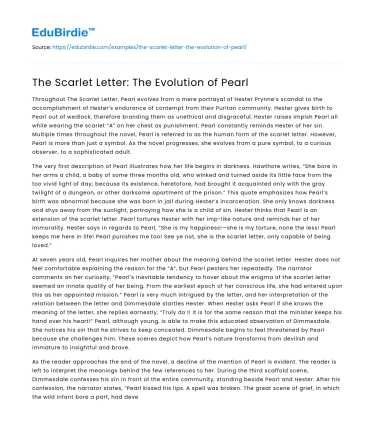Throughout The Scarlet Letter, Pearl evolves from a mere portrayal of Hester Prynne’s scandal to the accomplishment of Hester’s endurance of contempt from their Puritan community. Hester gives birth to Pearl out of wedlock, therefore branding them as unethical and disgraceful. Hester raises impish Pearl all while wearing the scarlet “A” on her chest as punishment. Pearl constantly reminds Hester of her sin. Multiple times throughout the novel, Pearl is referred to as the human form of the scarlet letter. However, Pearl is more than just a symbol. As the novel progresses, she evolves from a pure symbol, to a curious observer, to a sophisticated adult.
The very first description of Pearl illustrates how her life begins in darkness. Hawthore writes, “She bore in her arms a child, a baby of some three months old, who winked and turned aside its little face from the too vivid light of day; because its existence, heretofore, had brought it acquainted only with the gray twilight of a dungeon, or other darksome apartment of the prison.” This quote emphasizes how Pearl’s birth was abnormal because she was born in jail during Hester’s incarceration. She only knows darkness and shys away from the sunlight, portraying how she is a child of sin. Hester thinks that Pearl is an extension of the scarlet letter. Pearl tortures Hester with her imp-like nature and reminds her of her immorality. Hester says in regards to Pearl, “She is my happiness!—she is my torture, none the less! Pearl keeps me here in life! Pearl punishes me too! See ye not, she is the scarlet letter, only capable of being loved.”
Save your time!
We can take care of your essay
- Proper editing and formatting
- Free revision, title page, and bibliography
- Flexible prices and money-back guarantee
At seven years old, Pearl inquires her mother about the meaning behind the scarlet letter. Hester does not feel comfortable explaining the reason for the “A”, but Pearl pesters her repeatedly. The narrator comments on her curiosity, “Pearl’s inevitable tendency to hover about the enigma of the scarlet letter seemed an innate quality of her being. From the earliest epoch of her conscious life, she had entered upon this as her appointed mission.“ Pearl is very much intrigued by the letter, and her interpretation of the relation between the letter and Dimmesdale startles Hester. When Hester asks Pearl if she knows the meaning of the letter, she replies earnestly, “Truly do I! It is for the same reason that the minister keeps his hand over his heart!” Pearl, although young, is able to make this educated observation of Dimmesdale. She notices his sin that he strives to keep concealed. Dimmesdale begins to feel threatened by Pearl because she challenges him. These scenes depict how Pearl’s nature transforms from devilish and immature to insightful and brave.
As the reader approaches the end of the novel, a decline of the mention of Pearl is evident. The reader is left to interpret the meanings behind the few references to her. During the third scaffold scene, Dimmesdale confesses his sin in front of the entire community, standing beside Pearl and Hester. After his confession, the narrator states, “Pearl kissed his lips. A spell was broken. The great scene of grief, in which the wild infant bore a part, had developed all her sympathies; and as her tears fell upon her father’s cheek, they were the pledge that she would grow up amid human joy and sorrow, nor for ever do battle with the world, but be a woman in it. Towards her mother, too, Pearl’s errand as a messenger of anguish was all fulfilled.” Pearl shows her forgiveness of Dimmesdale with her kiss, and she will never be her mother’s torturer again. She is finally relieved of her mischievous disposition and has the ability to become a proper woman.
In the conclusion of the novel, it is reasonable to conclude that Pearl’s life is notably stable. “So Pearl—the elf-child,—the demon offspring, as some people, up to that epoch, persisted in considering her—became the richest heiress of her day, in the New World. Not improbably, this circumstance wrought a very material change in the public estimation…”, says the narrator of Pearl’s prosperity. Pearl seized her revenge at life and no doubt made Hester proud. Her childhood knocked her down over and over again, but she managed to stay afloat and go above and beyond everyone’s expectations, which goes to show her persistent tenacity.






 Stuck on your essay?
Stuck on your essay?

